Hebden Royd Town Council has unanimously passed Cllr Dave Young’s motion that the Council should refuse Sainsbury’s request for a meeting to discuss their proposal to build a Sainsbury’s Local on the old fire station site on Valley Road, and should instead invite Sainsbury’s to call a public meeting to discuss their proposals.
Cllr Young told the packed Council meeting, where many members of the public had to stand or sit on the floor,
“I don’t think it’s right for Councillors to meet with any developer. We should encourage Sainsbury’s to hold a public meeting. If they submit a planning application after that, there will be another debate in Council and then the application will go to Calderdale Council.”
Town Clerk Jason Boom told the meeting,
“We received a letter completely out of the blue from Sainsbury’s. After we’d received the letter, planning permission for the site expired on 31st December and the site is now vacant without any allocated use. We have received 10 or 11 communications from members of the public, all generally against the proposal.”
Public Objections to Sainsbury’s Local
Hilary Chadwick, spokesperson for the newly-formed group SOS Hebden Bridge (variously named as Save Our Shops Hebden Bridge or Sod Off Sainsbury’s Hebden Bridge) objected to the possibility of a Sainsbury’s Local on Valley Road.
She said that:
- supermarkets damage local independent businesses, take money out of the community and damage the vitality and vibrancy of towns
- the Competition Commission has shown that Sainsbury’s get more money from local stores than they do from supermarkets and that as a result they are pushing to develop more local stores, while 80% of independent shops on UK high streets have closed
- once independent shops have closed, supermarkets can raise their prices, leaving communities worse off
- the closure of Hebden Bridge independent shops would make it harder for the town to sell itself as a tourist destination
- supermarkets waste a huge amount of food before it even gets to the supermarket, because of their insistence on standardardised produce and their high volume, low price food purchasing forces farmers into intensive farming which damages the land
- between 2008-2010, Tesco, Sainsbury’s and Asda created half the number of jobs they had pledged to generate
- there are specific planning issues with the old fire station site, such as traffic, noise and waste issues
She concluded,
“I ask the Town Council, please say no to another supermarket in Hebden Bridge.”
Cllr Robin Dixon said,
“I’d urge you when the planning document comes out, that every single person writes a letter to the Planning Committee, and turns up at meetings. Petitions are no use – a petition only counts as one person’s objection, even if 300 or 500 people have signed it.”
Cllr Bampton Smith said that the letters all need to be from individuals, not from a group, and they all need to be different.
Cllr Timbers said,
“Another thing we can ask for is a retail impact assessment.”
A fair affordable food policy and Neighbourhood Planning
Myra James, on behalf of Incredible Edible Mytholm, asked Councillors two questions:
- Is Hebden Royd Town Council interested in developing and adopting a Fair, Affordable Food Policy?
- How does the proposal for a Sainsbury’s Local on Valley Road fit in with the proposed Neighbourhood Plan? Incredible Edible Mytholm recommends that the context of a Fair, Affordable Food Policy should inform any discussion regarding the Sainsbury’s proposal and development of the Neighbourhood Plan.
Explaining why Incredible Edible Mytholm think the Town Council needs a Fair Affordable Food Policy, Myra said,
“We have become aware that the planning system does not allow councillors to take into account the environmental, social and public health knock-on effects of proposed retail developments.
The Fair, Affordable Food Policy would take on board both the need for affordable food for all income groups and the need to create jobs, two factors often put forward in support of supermarket developments.
We are looking at the example Bristol City Council’s Food Policy Council and policy proposals set out by Dr. Charlie Clutterbuck, a Food Policy Fellow at City University, who spoke at our Field Day in the Town Hall last March.
We aim to hold a public consultation event in spring to bring together individuals and organisations to consider what a fair, affordable food policy, for Hebden Royd and for Calderdale, might look like.”
Cllr Jonathan Timbers replied,
“It’s hard to answer the first part of the question without seeing documents about the proposals for a Fair Affordable Food Policy, but if Incredible Edible Mytholm wants to talk to Councillors about this, I’m very happy to talk. It would be particularly useful if a Fair Affordable Food Policy results in practical stuff. We have to recognise that HRTC has very limited powers and resources. It’s not like Karl here is Mayor of New York.
You can’t say in a Neighbourhood Plan, ‘We don’t want Sainsbury’s’. It would be unlawful and not in the realms of possibility. You can’t say that you don’t want specific businesses. But there are useful things in Neighbourhood Planning.”
Town Clerk Jason Boom pointed out that IEM’s questions would be minuted. He said,
“As we work on the Neighbourhood Plan, we’ll be back in touch with Incredible Edible Mytholm.”
Hebden Royd Town Council Neighbourhood Plan process – a positive step forward
Cllr Timbers reported that, on behalf of the Neighbourhood Plan Working Group, he had written to all surrounding parish councils. With the exception of Wadsworth, which had not yet responded because there was no Town Clerk, all are interested in working together on a Neighbourhood Plan for the whole area. Once there is a defined area, the parish councils can go to Calderdale MBC and their obligation to support the Neighbourhood Plan process kicks in.
Cllr Timbers said,
“That’s a very positive step forward.”
Cllr Timbers also reported on a Yorkshire Local Councils Association training day on Neighbourhood Planning. He said that the politics behind the coalition government’s changes to the planning landscape with the Localism Act 2011 were to “remove parish councils as a barrier to growth” – a quote from business.
The aim of the training day was to get parish councils on board, rather than opposing Neighbouhood planning.
He showed a slide from the training day that showed that the principle behind the National Planning Policy Framework was to end public objections to planning applications.
In doublethink fashion though, one of the stated aims of Neighbourhood Planning is to “empower” local communities.
There are incentives to parish councils to make Neighbourhood Plans – it gives them a sizable, uncapped proportion of the community infrastructure levy, paid directly to the parish council for each development.
Cllr Timbers explained that “material considerations” are considerations not mentioned in the National Planning Policy Framework, the local plan or the neighbourhood plan (as appropriate) that are relevant (i.e. material) to an application and which may carry sufficient weight to justify refusal or conditions being placed on approval.
So material considerations allow Neighbourhood Plans to depart from the local plan, but there is no definition of what material considerations are. There are some case law examples though, eg material considerations in case law include the local economy, preserving community life, viability, and previous similar decisions.
Non-material considerations – things you can’t include in planning decisions – include the character of the applicant, and commercial competition – ie the possibility that a development would cause other businesses to close down.
Cllr Timber said,
“There are lots of grey areas in Neighbourhood Planning – you can’t have anything you want – no blue sky horizons stuff. It has to be specific things that allow people to do something.”
He gave the example of a Neighbourhood Plan that had allowed self-build housing on farm land where housing would not normally be permitted, but was allowed so that the farm families and employees had access to affordable housing.
“It has to be evidence-based, that there is a need/ demand.”
Hilary Chadwick said that the SOS Hebden Bridge website will carry information for people to use, when writing letters of objection against Sainsbury’s Local.
Back at Old Gate…
The busy Council meeting also unanimously refused Micheal Green’s application to stop up Old Gate cobbles outside the former Hole in the Wall, on the grounds that it is a public highway in regular use.
Since Section 116 of the Highways Act 1980 applied to the proposal, the Council’s refusal to support it means that the application can go no further.
Accredited Living Wage Council
Another notable event was the report that the Living Wage Foundation has accredited HRTC as a Living Wage employer.
Cllr Press said,
“I’m very proud that we have accredited living wage status. That means that all Council employees and Picture House staff are paid a living wage. Thanks to Jason and the team for doing all the work.”
Updated 12 Jan 2014 to remove the incorrect statement that the Neighbourhood Plan Working Group had not met, and to expand the explanation of the meaning of “material considerations”, as applied to planning.

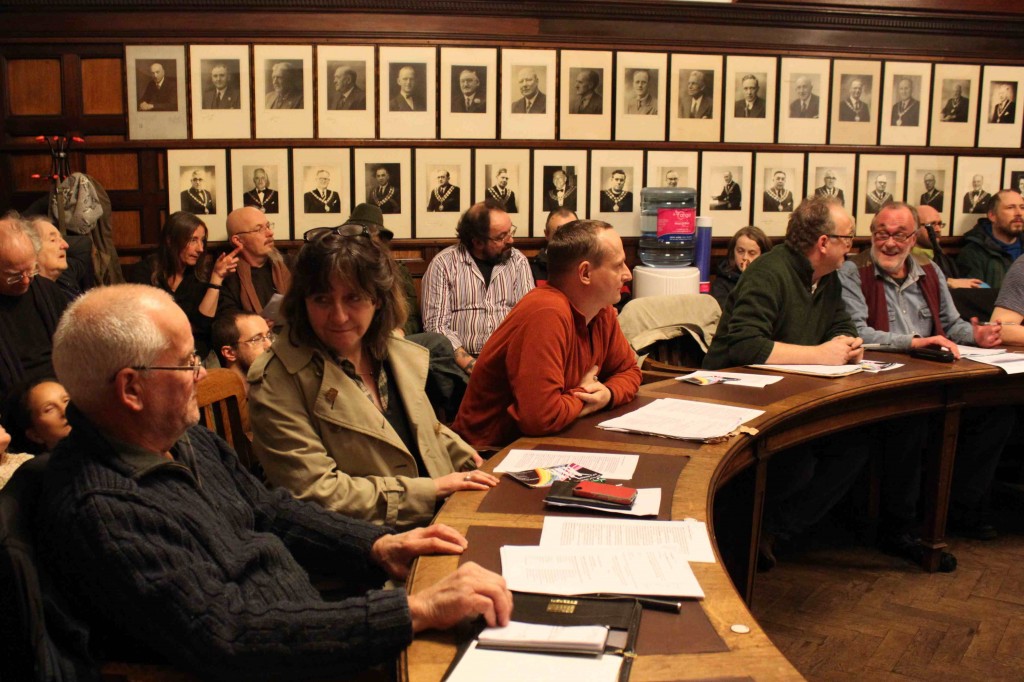
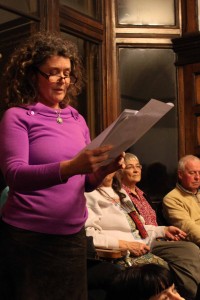
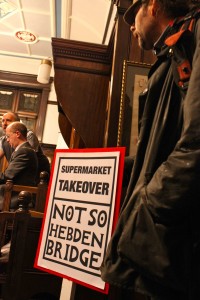
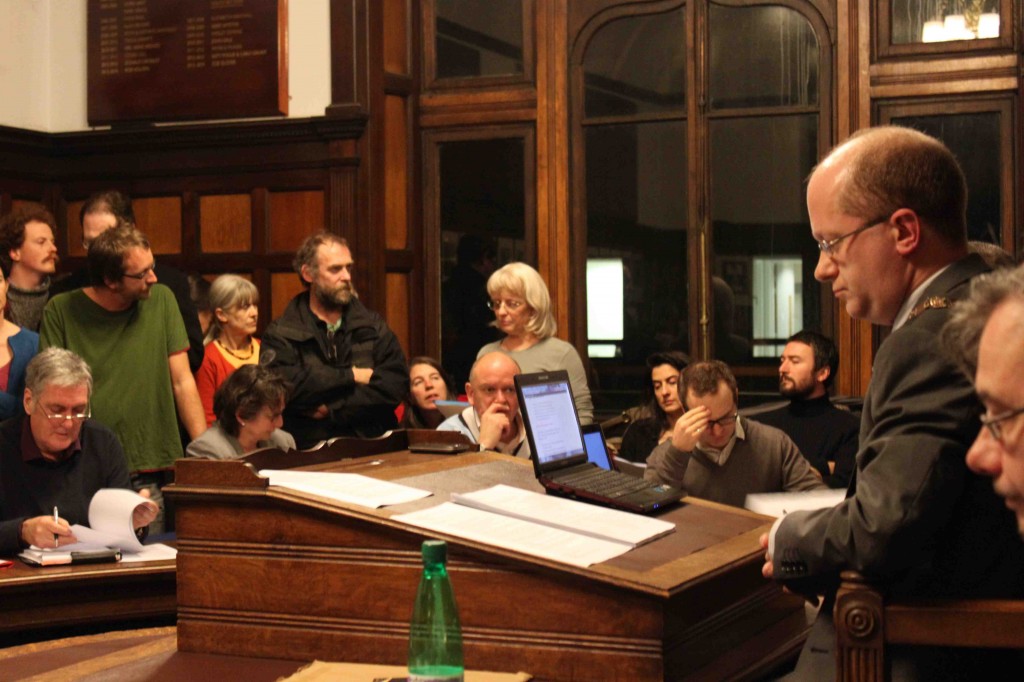
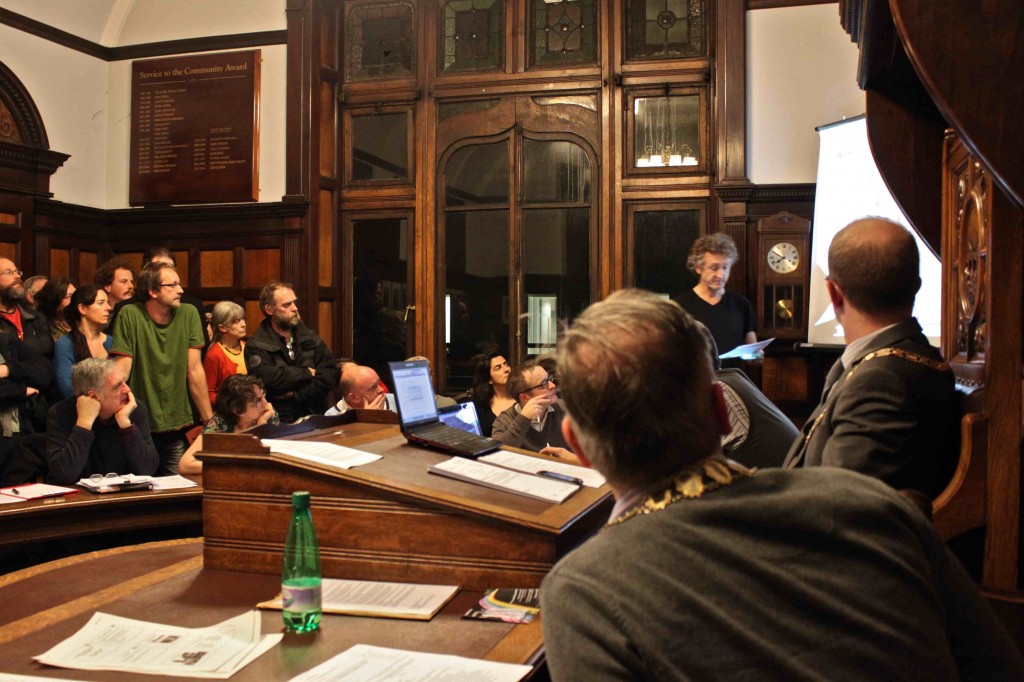
In the face of horrible odds (the Localism Act 2011) some brilliant work is being done by people in IEM and SOS (nice name).